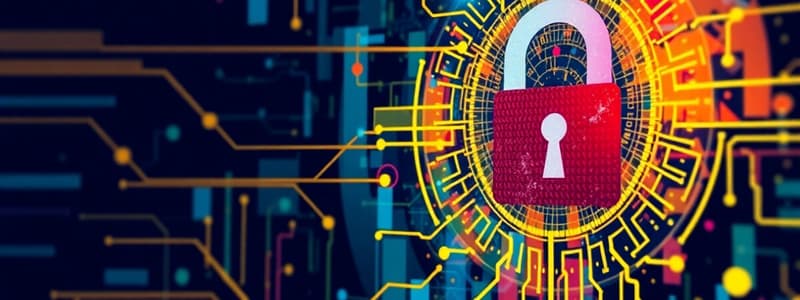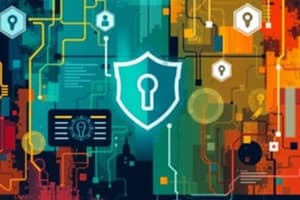Podcast
Questions and Answers
What is the purpose of a compliance liaison in an organization?
What is the purpose of a compliance liaison in an organization?
- To develop new software applications
- To establish service-level agreements
- To manage data security incidents
- To ensure adherence to organizational policies (correct)
Which of the following agreements would typically include performance metrics for services provided?
Which of the following agreements would typically include performance metrics for services provided?
- Memorandum of understanding (MOU)
- Service-level agreement (SLA) (correct)
- Interconnection security agreement (ISA)
- Blanket purchase agreement (BPA)
What does remediation refer to in the context of computer systems?
What does remediation refer to in the context of computer systems?
- Establishing data privacy policies
- Fixing security vulnerabilities (correct)
- Documenting user actions
- Creating new software solutions
Which of the following is a common misconception users have about computer ethics?
Which of the following is a common misconception users have about computer ethics?
What aspect of outsourcing is primarily concerned with controlling sensitive data?
What aspect of outsourcing is primarily concerned with controlling sensitive data?
What is the primary role of security administration within an organization?
What is the primary role of security administration within an organization?
What is typically located in a security operations center (SOC)?
What is typically located in a security operations center (SOC)?
Which component is essential in an IT security policy to protect information assets?
Which component is essential in an IT security policy to protect information assets?
Why are compliance and professional ethics important in security operations?
Why are compliance and professional ethics important in security operations?
What do identification assertions made by users pertain to?
What do identification assertions made by users pertain to?
Which management process focuses on tracking and controlling changes in an organization?
Which management process focuses on tracking and controlling changes in an organization?
What cycle includes the system development life cycle (SDLC) as part of its process?
What cycle includes the system development life cycle (SDLC) as part of its process?
What is a key element of data classification standards in information security?
What is a key element of data classification standards in information security?
What does authentication refer to in the context of a security system?
What does authentication refer to in the context of a security system?
What is meant by authorization in security terms?
What is meant by authorization in security terms?
Which of the following is NOT a common documentation requirement for security?
Which of the following is NOT a common documentation requirement for security?
How does an organization's security team respond to incidents and disasters?
How does an organization's security team respond to incidents and disasters?
One of the disadvantages of security outsourcing is that an organization may:
One of the disadvantages of security outsourcing is that an organization may:
What comprises accountability in a security context?
What comprises accountability in a security context?
Which type of compliance involves adherence to laws and regulations?
Which type of compliance involves adherence to laws and regulations?
What is one role of emergency operations groups in security administration?
What is one role of emergency operations groups in security administration?
What is one justification that hackers might use to validate their actions?
What is one justification that hackers might use to validate their actions?
What is one of the key components of a code of ethics in a professional setting?
What is one of the key components of a code of ethics in a professional setting?
Which principle emphasizes that an organization should only collect necessary information?
Which principle emphasizes that an organization should only collect necessary information?
What is the purpose of mandatory vacations in the context of personnel security?
What is the purpose of mandatory vacations in the context of personnel security?
Which of the following is NOT a component of an IT security policy infrastructure?
Which of the following is NOT a component of an IT security policy infrastructure?
What are the Internet Architecture Board's expectations regarding unethical online practices?
What are the Internet Architecture Board's expectations regarding unethical online practices?
What is the significance of security awareness training in personnel security?
What is the significance of security awareness training in personnel security?
Which of the following is an ethical argument hackers might use regarding accessing information?
Which of the following is an ethical argument hackers might use regarding accessing information?
What is the primary purpose of configuration control?
What is the primary purpose of configuration control?
Which of the following best describes proactive change management?
Which of the following best describes proactive change management?
What steps must a change control committee ensure for changes?
What steps must a change control committee ensure for changes?
What is a back-out plan in change control?
What is a back-out plan in change control?
Why is it important to keep documentation current during the change management process?
Why is it important to keep documentation current during the change management process?
Which of the following is an example of a reactive change management approach?
Which of the following is an example of a reactive change management approach?
What is an example of a potential issue in change control?
What is an example of a potential issue in change control?
Effective communication during the change management process is essential for which reason?
Effective communication during the change management process is essential for which reason?
What is the final step in the System Development Life Cycle (SDLC)?
What is the final step in the System Development Life Cycle (SDLC)?
Which of the following should be included in the testing of application software?
Which of the following should be included in the testing of application software?
What is the purpose of system disposal in the System Life Cycle?
What is the purpose of system disposal in the System Life Cycle?
Why is it important to formalize the process for procuring new equipment?
Why is it important to formalize the process for procuring new equipment?
What is a key activity that should occur during acceptance testing?
What is a key activity that should occur during acceptance testing?
Which of the following activities is crucial when testing new software?
Which of the following activities is crucial when testing new software?
What is one of the primary goals of the System Life Cycle?
What is one of the primary goals of the System Life Cycle?
Which aspect of vendor evaluation is crucial for long-term system sustainability?
Which aspect of vendor evaluation is crucial for long-term system sustainability?
Flashcards
Security Operations
Security Operations
The planning, implementing, and monitoring of an organization's security.
Security Policies
Security Policies
Rules and guidelines for IT security.
Security Audits
Security Audits
Evaluations of IT security measures.
Security Administration
Security Administration
Signup and view all the flashcards
Security Operations Center (SOC)
Security Operations Center (SOC)
Signup and view all the flashcards
Information Assets
Information Assets
Signup and view all the flashcards
Identification (in security)
Identification (in security)
Signup and view all the flashcards
Change Management
Change Management
Signup and view all the flashcards
Outsourcing Agreements
Outsourcing Agreements
Signup and view all the flashcards
Service-Level Agreement (SLA)
Service-Level Agreement (SLA)
Signup and view all the flashcards
Compliance Liaison
Compliance Liaison
Signup and view all the flashcards
Remediation
Remediation
Signup and view all the flashcards
Ethical Guidelines & Standards
Ethical Guidelines & Standards
Signup and view all the flashcards
Authentication
Authentication
Signup and view all the flashcards
Authorization
Authorization
Signup and view all the flashcards
Accountability
Accountability
Signup and view all the flashcards
Sensitive Assets List
Sensitive Assets List
Signup and view all the flashcards
Regulatory Compliance
Regulatory Compliance
Signup and view all the flashcards
Organizational Compliance
Organizational Compliance
Signup and view all the flashcards
Incident Response Team
Incident Response Team
Signup and view all the flashcards
Emergency Operations Groups
Emergency Operations Groups
Signup and view all the flashcards
Unethical hacking justifications
Unethical hacking justifications
Signup and view all the flashcards
Code of Ethics
Code of Ethics
Signup and view all the flashcards
Internet Architecture Board (IAB) statement
Internet Architecture Board (IAB) statement
Signup and view all the flashcards
Privacy Principles
Privacy Principles
Signup and view all the flashcards
Personnel Security Principles
Personnel Security Principles
Signup and view all the flashcards
Limiting Access
Limiting Access
Signup and view all the flashcards
Security Policy Hierarchy
Security Policy Hierarchy
Signup and view all the flashcards
Configuration Control
Configuration Control
Signup and view all the flashcards
Change Control
Change Control
Signup and view all the flashcards
Reactive Change Management
Reactive Change Management
Signup and view all the flashcards
Proactive Change Management
Proactive Change Management
Signup and view all the flashcards
Change Control Committees
Change Control Committees
Signup and view all the flashcards
Peer Reviews
Peer Reviews
Signup and view all the flashcards
Back-out Plans
Back-out Plans
Signup and view all the flashcards
System Life Cycle (SLC)
System Life Cycle (SLC)
Signup and view all the flashcards
System Development Life Cycle (SDLC)
System Development Life Cycle (SDLC)
Signup and view all the flashcards
What's the difference between SDLC and SLC?
What's the difference between SDLC and SLC?
Signup and view all the flashcards
Acceptance Testing
Acceptance Testing
Signup and view all the flashcards
What is the purpose of testing application software?
What is the purpose of testing application software?
Signup and view all the flashcards
Why is it important to thoroughly evaluate changes to the system environment?
Why is it important to thoroughly evaluate changes to the system environment?
Signup and view all the flashcards
How is the Common Criteria used in systems procurement?
How is the Common Criteria used in systems procurement?
Signup and view all the flashcards
Why is it important to monitor vendor contracts and SLAs?
Why is it important to monitor vendor contracts and SLAs?
Signup and view all the flashcards
Study Notes
Security Operations and Administration
- Fundamentals of Information Systems Security, Fourth Edition, by David Kim and Michael G. Solomon, is the textbook
- Security operations, policies, audits, testing, and monitoring are crucial components in IT infrastructure.
- Security administration encompasses planning, designing, implementing, and monitoring an organization's security plan.
- The security operations center (SOC) is the physical location for security administration
- Information assets must be identified and documented, and assigned to individuals or positions.
Controlling Access
- Identification involves users asserting who they are.
- Authentication verifies these assertions.
- Authorization determines the permissions for legitimate users/processes.
- Accountability tracks the actions of both authenticated and unauthenticated users.
Documentation, Procedures, and Guidelines
- Essential documentation includes sensitive assets, security processes, and the authority of responsible personnel.
- Security policies, procedures, and guidelines need to be in place for compliance purposes.
- Compliance occurs on two levels: regulatory and organizational.
Disaster Assessment and Recovery
- The security administration team handles incidents and disasters.
- An incident response team works to investigate security breaches.
- Emergency operations groups (if necessary) protect sensitive data.
Security Outsourcing
- Advantages include expertise inaccessible in-house.
- Disadvantages encompass the lack of internal knowledge within the outsourcing firm and the ongoing cost to the organization.
Outsourcing Considerations
- Privacy, risk, data security, ownership, and adherence to policy are critical considerations for outsourcing.
Common Outsourcing Agreements
- Service-level agreements (SLAs), blanket purchase agreements (BPAs), memorandums of understanding (MOUs), and interconnection security agreements (ISAs) are common outsourcing agreements.
Compliance
- Event logs record actions from operating systems and applications.
- Compliance liaisons ensure personnel understand and comply with policies.
- Remediation fixes broken or defective systems, including fixing vulnerabilities.
Professional Ethics
- Setting a good example, encouraging ethical behavior, and providing security awareness training are vital for ethical standards.
Common Fallacies About Ethics
- Users sometimes believe their computer usage, security, and information access are justified and excused as expressions of freedom of speech.
- They may think minor damage or abuse of systems is inconsequential.
- Misconceptions about hacking frequently arise.
Codes of Ethics
- A code of ethics promotes professionalism.
- The Internet Architecture Board (IAB) publishes guidelines on acceptable internet practices.
- Organizations should collect only necessary information, and do not share or use information outside of its initial intended purpose.
- Information should be kept up to date.
- Information should be properly destroyed once no longer needed.
Personnel Security Principles
- Access should be limited.
- Separation of duties, job rotation, and mandatory vacations are key security controls.
- Security training, awareness, and social engineering countermeasures must be considered..
The Infrastructure for an IT Security Policy
- It includes policies, standards, procedures, baselines, and guidelines
The Security Policy Environment
- Security policies are influenced by regulations, organizational objectives, laws, and shareholder interests.
- (Figure 9-1) depicts these influences.
The Security Policy Hierarchy
- A hierarchy of policies exists (Figure 9-2).
- Organizational security policy statements direct the entire security structure.
- Functional policies underpin organizational policies. (various examples are provided)
- Supporting mechanisms such as procedures and baselines are included.
Systematic Actions
- (Figure 9-3) depicts intrusion, tampering, and material destruction, all relating to corporate procedures.
Baseline Corporate Configuration
- (Figure 9-4) highlights VPN Setup, IDS Configuration, and Password Rules.
Data Classification Standards
- Data owners and system owners are critical to data classification standards.
- Classifying criteria includes value, sensitivity, and criticality.
Information Classification Objectives
- These objectives include identifying information requirements, valuing data, cost effectiveness and standards, informing all stakeholders, ensuring compliance with regulations and laws
Examples of Classification
- U.S. government classification (e.g., UnClassified, Secret, Top Secret) is highly standardized.
- Private sector classification varies by organization.
Classification Procedures
- Effective data classification depends on clear procedures.
- Determining the scope, process, and conducting a business impact analysis are crucial.
- Data value is assessed based on factors such as possession, utility, cost, liability, convertibility, operational impact and threats.
Assurance
- Internal and external auditors review data classification policies and procedures for compliance.
- Information security personnel need to routinely monitor classified materials. Incident reports are vital if violations occur.
Configuration Management
- This process manages the change process involved with managing computer and device configurations, assessing the impact of changes, and ensuring security professionals manage change.
Hardware Inventory and Configuration Chart
- Procedures exist to ensure configurations are up to date for hardware components for patches, and upgrades.
The Change Management Process
- Processes are in place to manage changes to baseline settings, configuration settings, and the change control process.
Change Control Management
- Procedures for change control include communication, proactive/reactive approaches, documentation in case of a change failure.
Change Control Committees
- Committees ensure changes are properly tested, authorized, scheduled, communicated and documented
Change Control Procedures
- (Figure 9-5) illustrates the steps in change control: Request, Impact Assessment, Approval, Build/Test, Implementation, and Monitoring.
Change Control Issues
- Peer reviews double-check changes.
- Back-out plans exist for restoring systems.
- Comprehensive documentation is vital.
Application Software Security
- Processes for software development include the system life cycle (SLC) and the system development life cycle (SDLC).
- Steps are similar, but SDLC ends with production.
The System Life Cycle
- The system life cycle involves initiation, planning, requirements, design, build, acceptance, implementation, operations, maintenance, and disposal.
Testing Application Software
- Tests encompass expected and unexpected actions, error handling, load testing (transaction volume, memory, bandwidth, and response times).
- Production and sensitive data must be protected during testing.
- New equipment should meet standards established for system security.
- Management must accept the security systems.
Systems Procurement
- Evaluating new solutions, vendors, and common criteria (maintenance, support, and training) are important.
- Installing equipment properly and following procurement process are required.
- Monitor systems and replace them at the end of their useful lifecycle.
Software Development and Security
- Applications must validate user authorization, recover from failure, handle errors, and maintain secure configuration baselines.
- Applications need frequent patches to ensure security.
Software Development Models
- Waterfall model and Agile development method are widely used.
The Waterfall Model
- (Figure 9-6) shows the sequential steps in the waterfall model: Requirements, Design, Construction, Integration, Testing, Installation, and Maintenance.
The Agile Software Development Method
- (Figure 9-7) illustrates the dynamic aspects.
Summary
- Key concepts for security operations and administration are summarized.
Studying That Suits You
Use AI to generate personalized quizzes and flashcards to suit your learning preferences.




